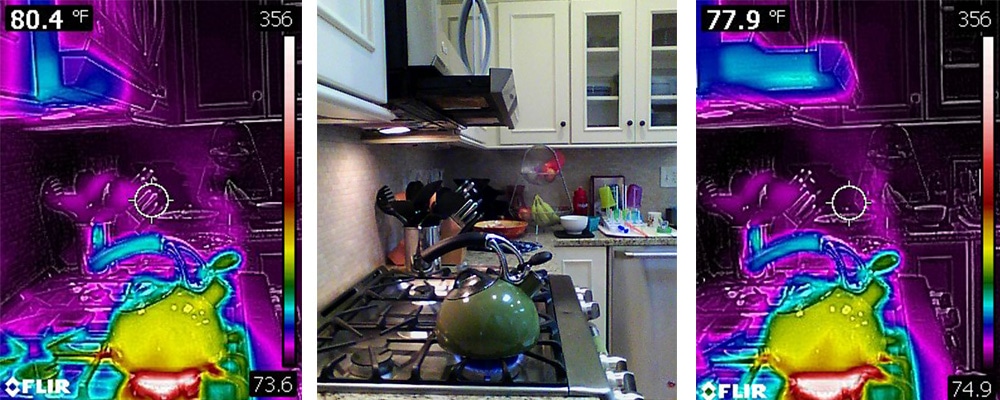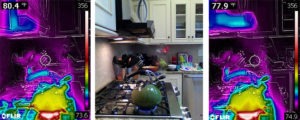

Blog
|
So, how effective is your kitchen hood? If yours is like most, the answer is not so effective on the front burners and, let’s be honest, those are the ones that we most often use.

Next time you are cooking, take a look at your kitchen hood. You are likely cooking on the front two burners, but your kitchen hood is not likely to extend fully over these burners. For typical exhaust fans, they do a good job of exhausting steam, contaminants, etc. from directly below them, but don’t necessarily pull all fumes that are outside the perimeter of the fan enclosure. According to Lawrence Berkeley National Laboratory (LBNL) the capture efficiency of standard hoods is typically in the range of 30-40% on front burners and can be as high as 90% on back burners. To demonstrate this, I boiled some water in a tea pot on my stove. Once steam was coming out, I pulled out an infrared camera and started to take images. Wait…you don’t have an IR camera just sitting around your home? You are missing out on hours and hours of fun with the kids. They are great for science projects.
Back to my point. I have an LG over-the-range microwave with extenda™ vent. This allows the vent area to extend out an additional ~6”. When the microwave hood (exhausted to outside) was operating on turbo mode (just over 300 cfm exhaust) and without the vent extension slid out, the majority of steam from the tea pot on the front burner was passing by the vent and going up the front of the microwave (as evidenced by moisture build up on the microwave door). And yes, I realize that I turned the spout of the tea pot outwards to more dramatically show the point I am trying to make. When the slide out vent was pulled out, the amount of steam capture increased dramatically, but there was still some moisture build up on the front edge of the vent slide out. Obviously, this is not a scientific study; it is just anecdotal evidence to further the discussion on the need to consider capture efficiency in the design of kitchen range hoods.

So, how effective is your kitchen hood? If yours is like most, the answer is not so effective on the front burners and, let’s be honest, those are the ones that we most often use. If this is the case, what should you do? The simple, but maybe not practical, answer is to use the back burners. The key is a range hood that extends over all burners. The smoke plume is literally hot air so it will naturally rise. As long as the hood covers the burner only 200 CFM or so is needed to capture the majority of the plume. Dedicated hoods perform much better than microwave exhausts partly because they tend to extend further. In my case, my microwave has the slide-out extension but still doesn’t fully cover the front burners. For other microwave exhausts, another option might be a hood extension such as the Microvisor. I just ordered one of these to do some additional home “testing” and I will update you once I have more information.
Beside the size of the range hood, the height above the stove also makes a big difference. Lower is better, though pay close attention to manufacturer minimum height recommendations and consider sight lines to the back burners and stove controls. If you are designing a new kitchen, take the time to properly design the kitchen exhaust system based on these principles to ensure that contaminants are actually exhausted from the home.
Fortunately, the industry is focusing on this issue more and more. There is a testing procedure for range hood effectiveness currently in ASTM process. Once the procedure is finalized consumers will be able to compare range hood effectiveness when purchasing and governments could require a minimum effectiveness in appliance standards and/or building codes.
For more information, check out some past studies by Lawrence Berkeley National Laboratory: http://indoorair.lbl.gov/index.html
Steven Winter Associates